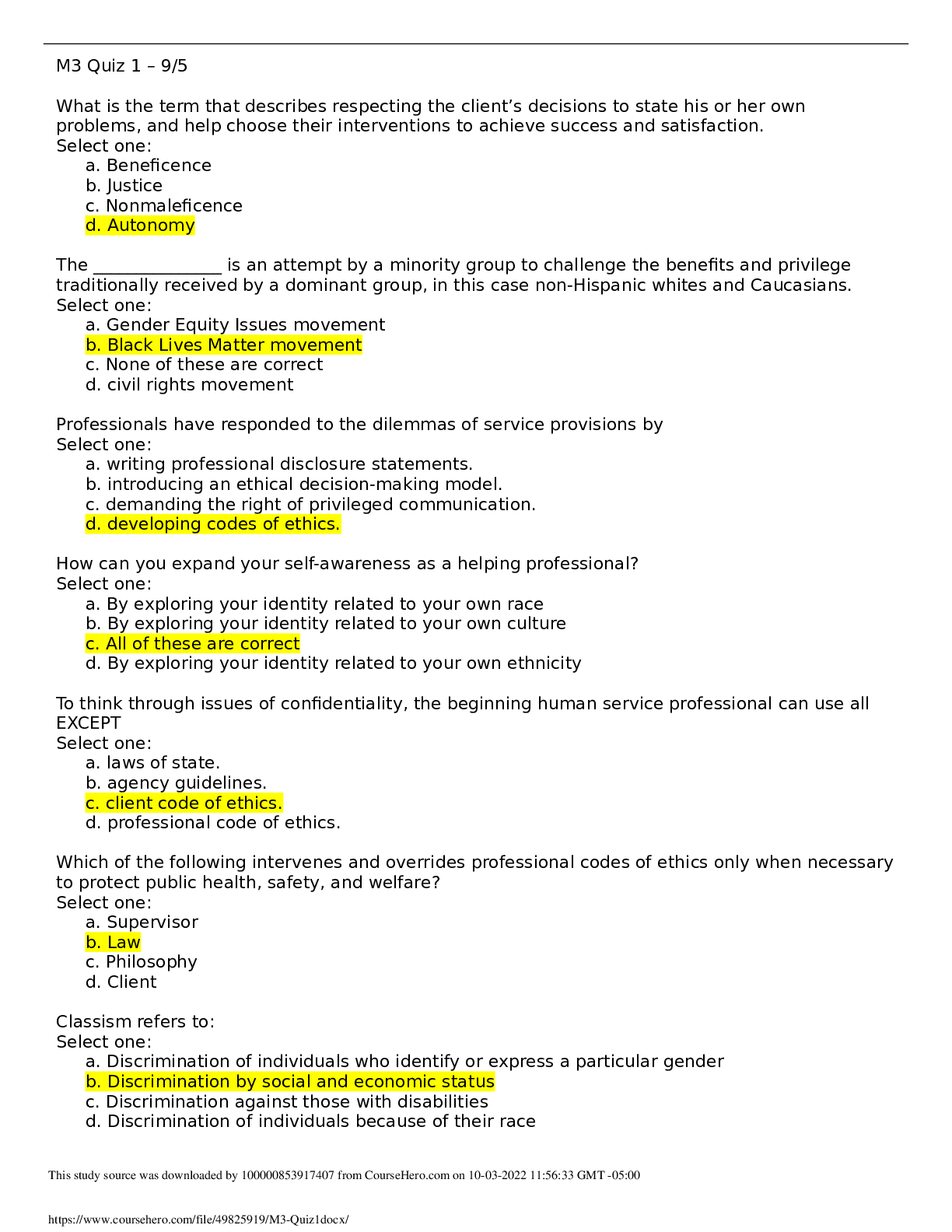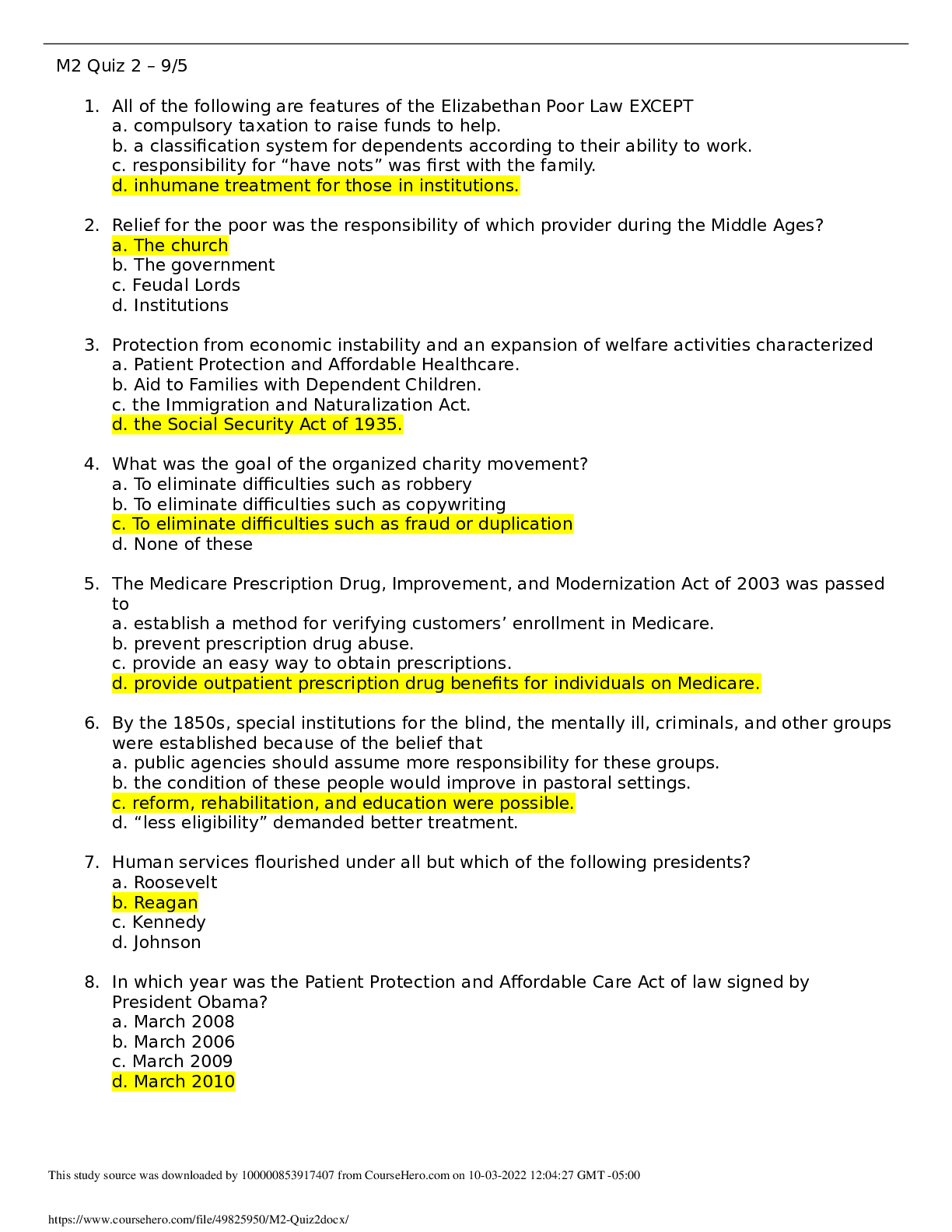Philosophy > QUESTIONS & ANSWERS > HUSV 2035 Introduction to Human Services M4 Quiz 1 | SUNY Empire State College (All)
HUSV 2035 Introduction to Human Services M4 Quiz 1 | SUNY Empire State College
Document Content and Description Below
M4 Quiz 1 – 9/6 The human service philosophy emphasizes the responsibilities of society and the importance of working with Select one: a. the whole person. b. a client’s physician. c. other ... professionals. d. accessible clients. Both the medical model and the public health model have which of the following in common? Select one: a. Using medical intervention b. Delivering services to cure an illness c. Helping those who are mentally ill d. Working to prevent the spread of disease Which model views mental disorders as the result of malfunctions or pressures created by the environment or by the society? Select one: a. Human service model b. None of these are correct c. Medical model d. Public health model Treatment in the medical model includes all EXCEPT Select one: a. psychiatric drugs. b. psychiatry. c. electroshock therapy. d. societal control. Which model is concerned with the interaction between the individual and the environment, stressing the need for balance between the two? Select one: a. All of these are correct. b. Human service model c. Public health model d. Medical model Public health and human services have which of the following in common? Select one: a. Treating individuals, families, and larger populations b. Hoping to help clients with day-to-day problems c. Helping clients find the right services d. Problem solving in the here and now The primary focus of the human service model is Select one: a. to emphasize prevention. b. to provide services that help individuals solve their problems. c. to focus on conditions that occur when individuals live in communities. d. to focus on the interpersonal and environmental conflicts. M4 Quiz 1 – 9/6 Three basic models of service delivery include traditional psychiatry, the public health approach, and the Select one: a. casework system. b. supernatural. c. human service model. d. psychopharmacology model. Recipients of services in the medical model are called Select one: a. clients. b. patients. c. individuals. d. consumers. Information about models of service delivery is important to human service professionals because Select one: a. they are likely to practice in other models. b. agencies hire those who are skilled in more than one model. c. they are likely to be working with professionals who practice other models. d. most problems require the services of at least two models. Motivational interviews focus on Select one: a. the housing and financial needs of the client. b. the client’s approach to change. c. the culture of the client. d. the gender of the client. Encouraging responsibility and promoting self-help are Select one: a. supported by the office setting. b. the goals of the helping process. c. the focus of questioning. d. the result of listening. A strategy or technique that helps the client become more comfortable with the setting and the helper is Select one: a. a handshake. b. questioning. c. listening. d. an icebreaker, A person’s posture, tone of voice, gestures, and eye contact are examples of Select one: a. active listening. b. nonverbal behaviors. c. effective communication. d. responding. M4 Quiz 1 – 9/6 Clients who may come for help more or less willingly but fail to carry through or participate are Select one: a. culturally different clients. b. Asian American clients. c. reluctant clients. d. resistant clients. The behaviors of helpers as they attend to both the verbal and nonverbal communication of the client is called Select one: a. the expression of feelings. b. “hearing” cues. c. active listening. d. effective communication Attending behavior includes the following nonverbal components EXCEPT Select one: a. attentive body language. b. eye contact. c. verbal tracking. d. vocal qualities. The cornerstone of helping is Select one: a. the helping relationship. b. the clients. c. rapport. d. communication skills. A dependent client, poor helping skills, and an unsatisfactory helping relationship are possible results of Select one: a. resistance. b. an overreliance on questions. c. ineffective communication. d. silence. Which of the following questions would not be considered helpful and appropriate? Select one: a. How does that make you feel? b. How long have you been ill? c. Why did you do that? d. Could you tell me a little about yourself? Within the hierarchy of needs, security needs are represented by Select one: a. having three good meals each day. b. having shelter. c. having a family. d. having friendships. M4 Quiz 1 – 9/6 Involuntary referral is illustrated by all EXCEPT Select one: a. inadvertent services by a human service agency. b. agreement of abusive parents to seek counseling. c. individuals incarcerated for crimes. d. juvenile court may order services for first offenders. From a human service perspective, problems in living have two components, which are Select one: a. a description and a course of action. b. an unsettled matter and a demand for services. c. determining who the client is and what the client needs. d. a situation and a difficulty. Barriers to seeking help include all but which of the following? Select one: a. Lack of money b. Lack of transportation c. Age d. Psychological costs To understand individuals as clients, (e.g., a homeless person) the human service worker needs to ask which of the following? Select one: a. Who do I know in this client group? b. How does this group experience a crisis? c. How does prevention affect this group? d. What is the stereotype of this group? A perspective that challenges power is Select one: a. Maslow’s hierarchy. b. developmental in growth patterns. c. the feminist perspective. d. gang-related theory. Client satisfaction is related to Select one: a. talking about problems. b. solving problems. c. making more money. d. making new friends. A job change, natural disasters, and an accident may result in Select one: a. rapid social change. b. an involuntary referral. c. developmental problems. d. situational problems. Developmental stages of the lifespan can be characterized by all of the following EXCEPT M4 Quiz 1 – 9/6 Select one: a. each stage is predictable. b. individuals engage in certain tasks or activities at different points in their lives. c. many healthy individuals are able to skip stages. d. many individuals experience sever developmental crises. Which of the following dimensions of the environment influences a client’s life? Select one: a. Results of rapid societal change b. Groups to which the client belongs c. All of these are correct. d. Specific location in which a client lives [Show More]
Last updated: 11 months ago
Preview 1 out of 5 pages
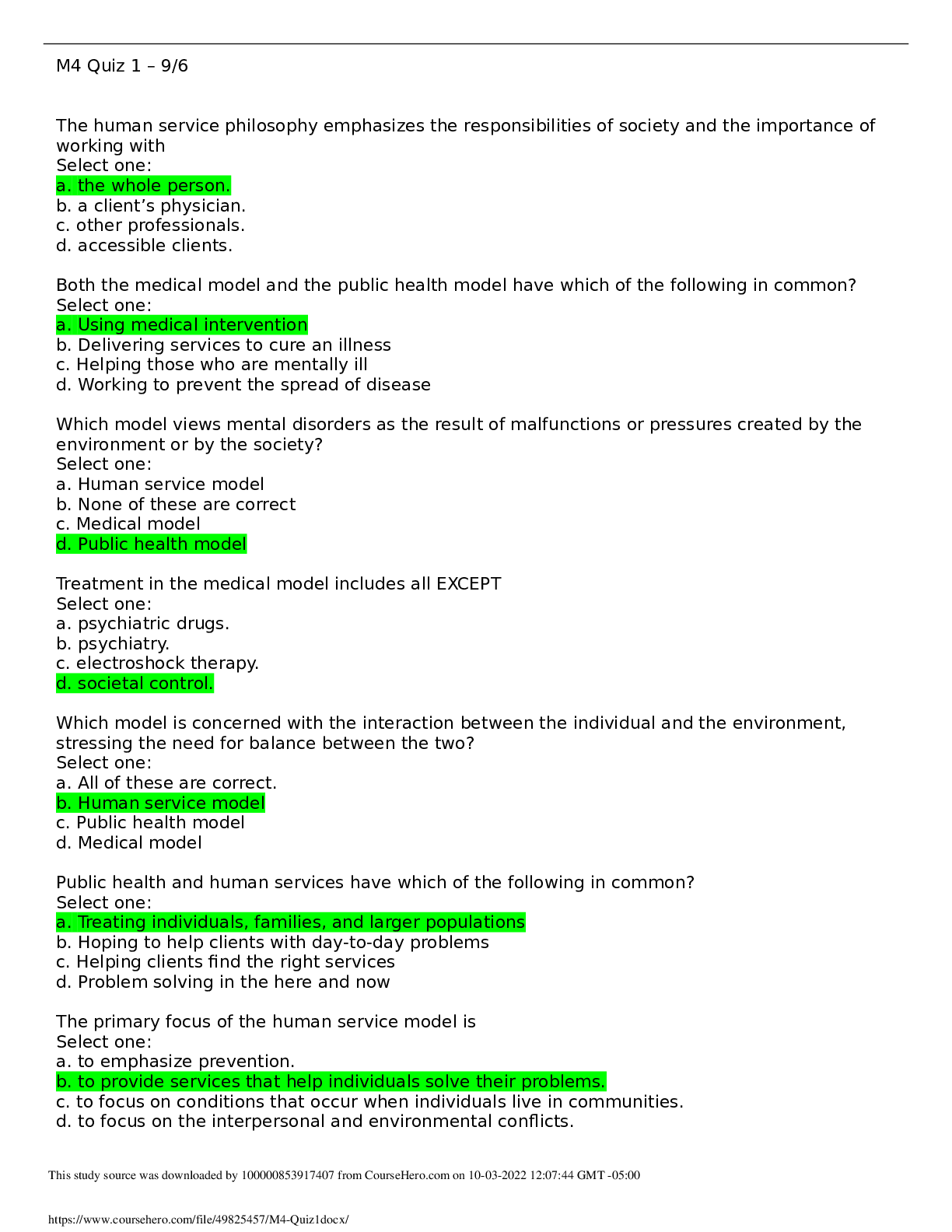
Buy this document to get the full access instantly
Instant Download Access after purchase
Buy NowInstant download
We Accept:

Reviews( 0 )
$4.00
Can't find what you want? Try our AI powered Search
Document information
Connected school, study & course
About the document
Uploaded On
Oct 03, 2022
Number of pages
5
Written in
Additional information
This document has been written for:
Uploaded
Oct 03, 2022
Downloads
0
Views
66

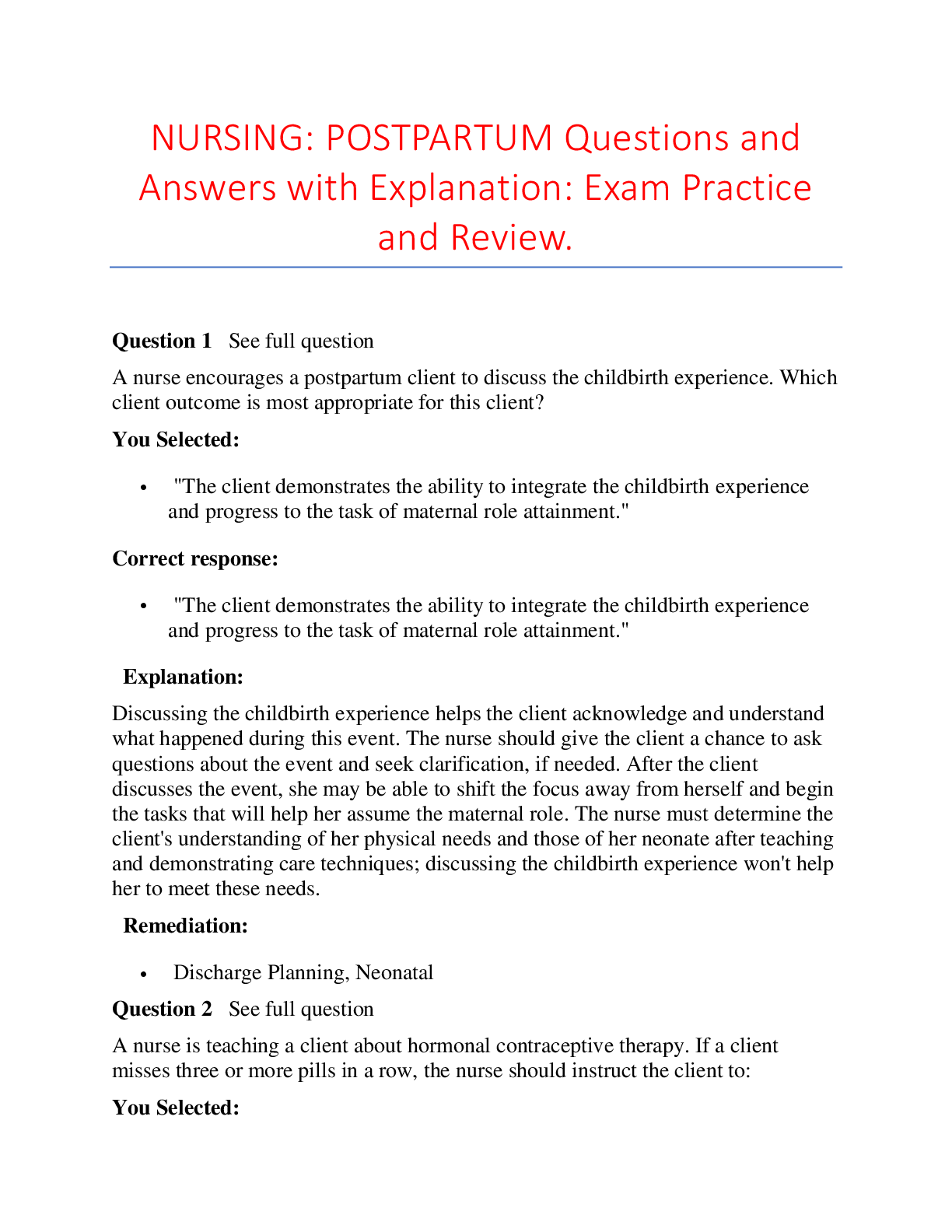
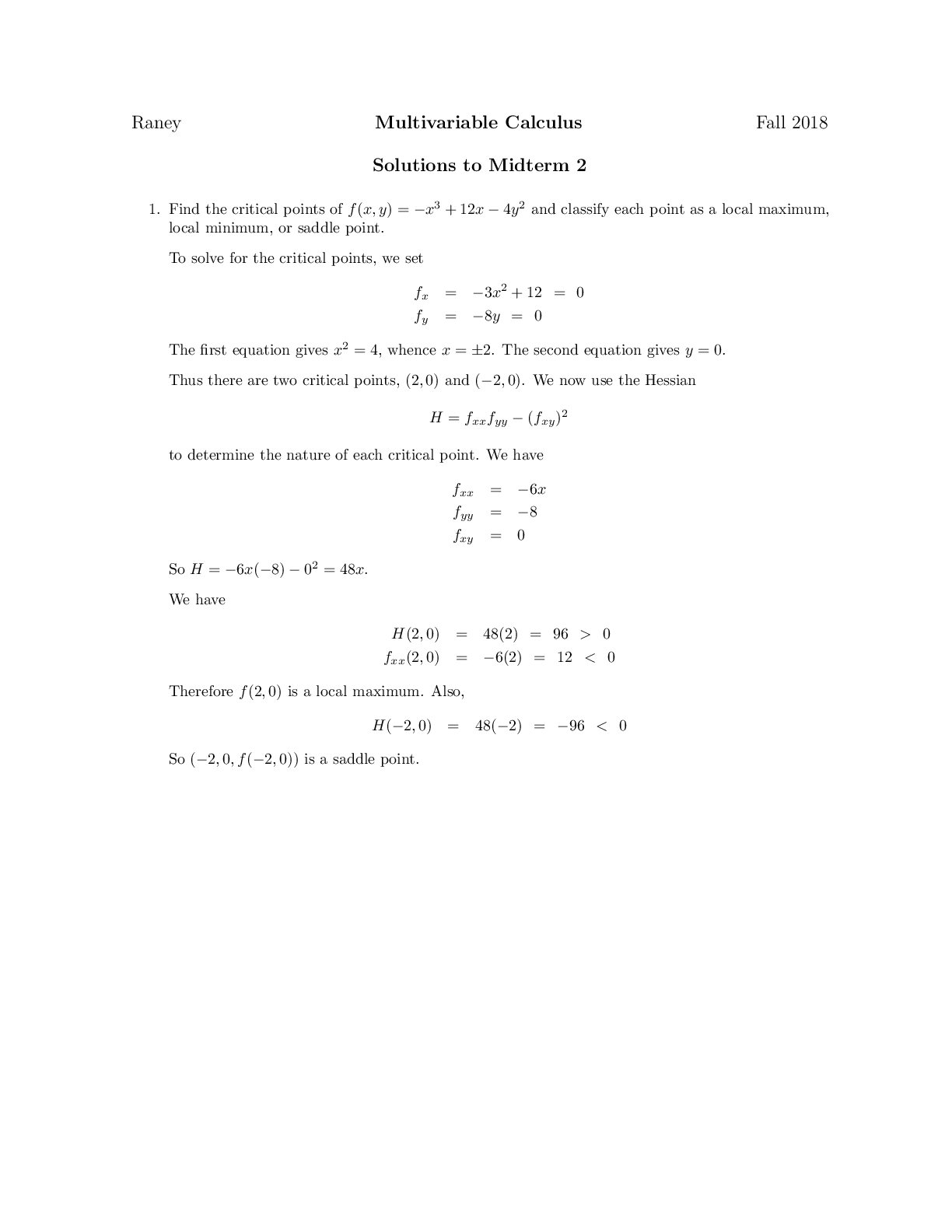


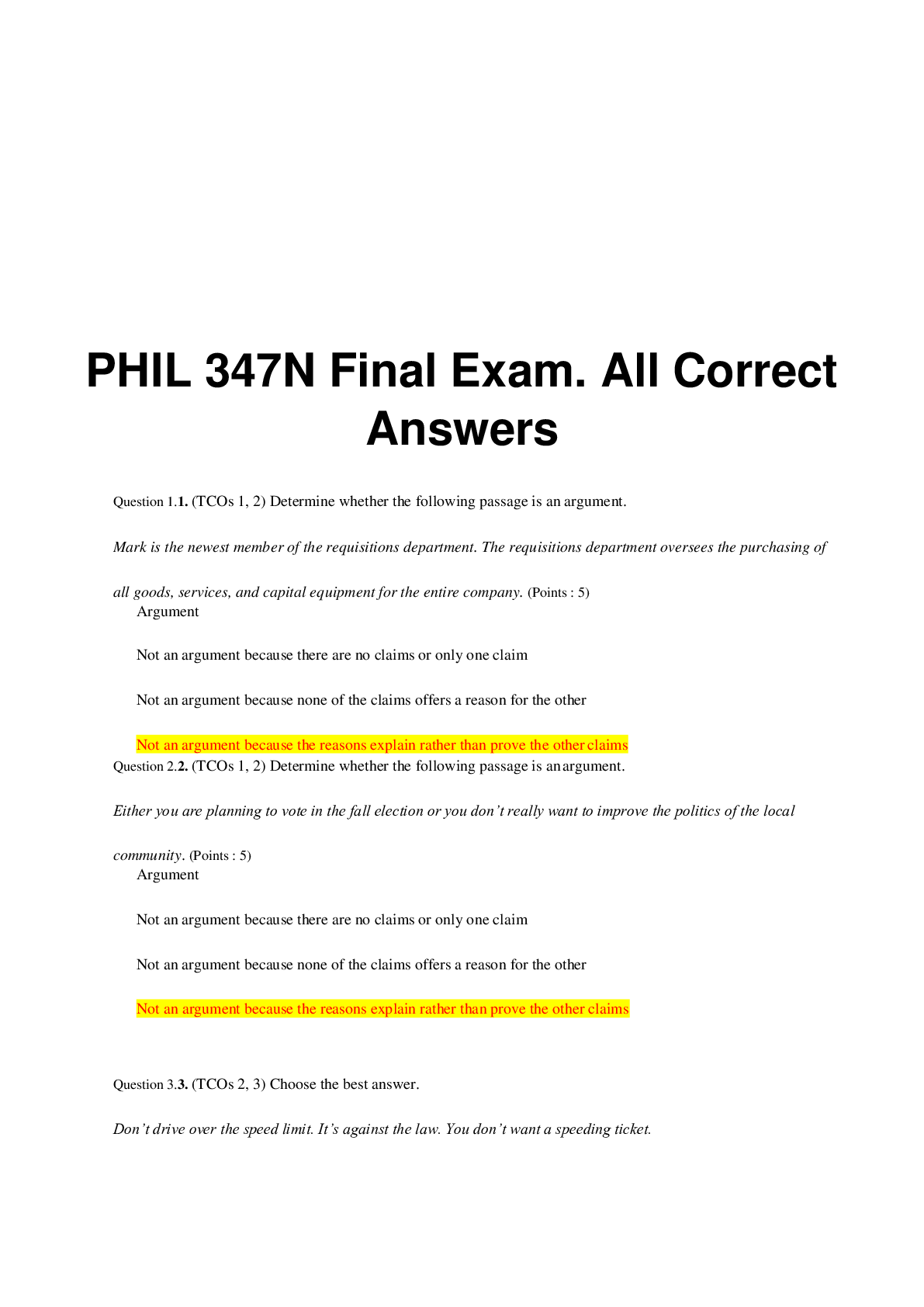
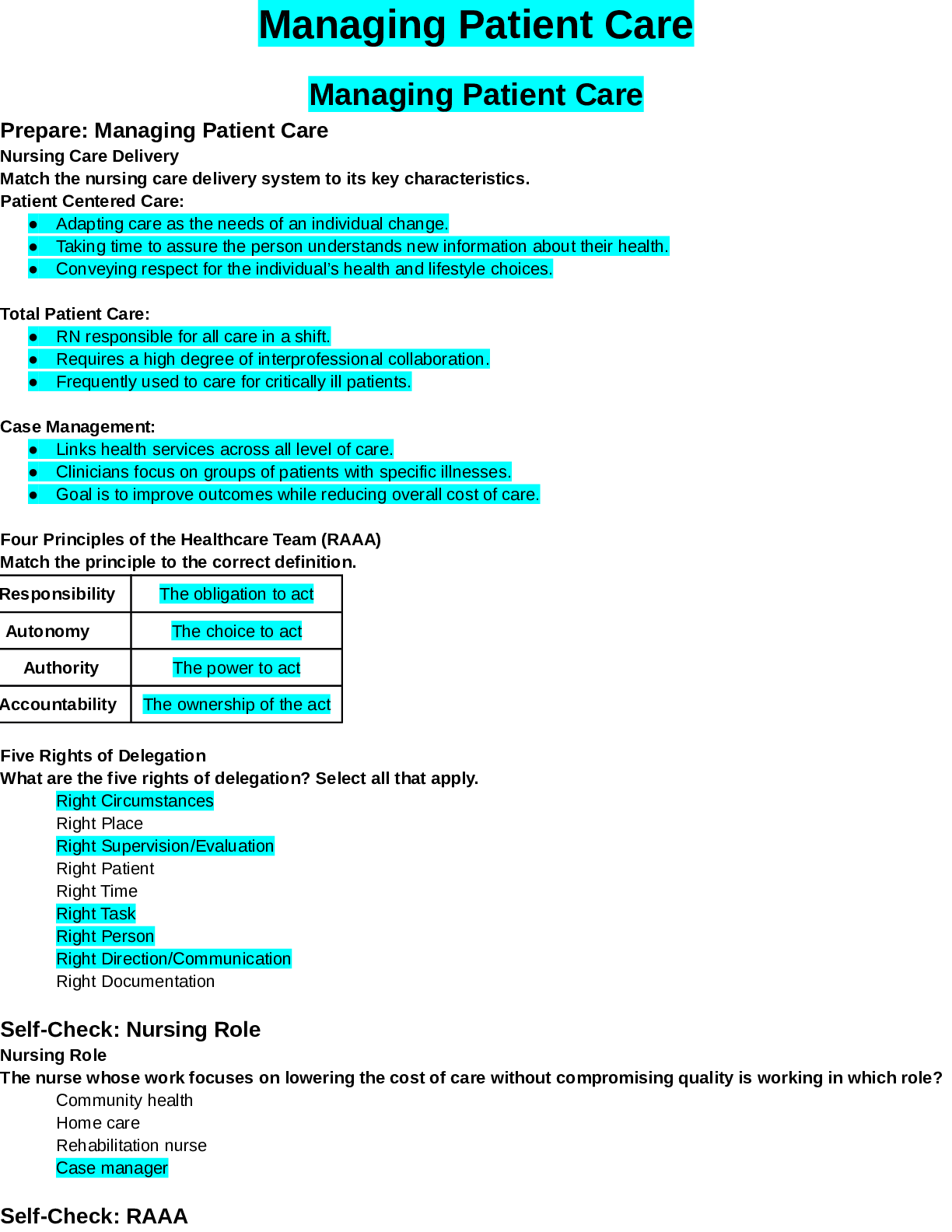




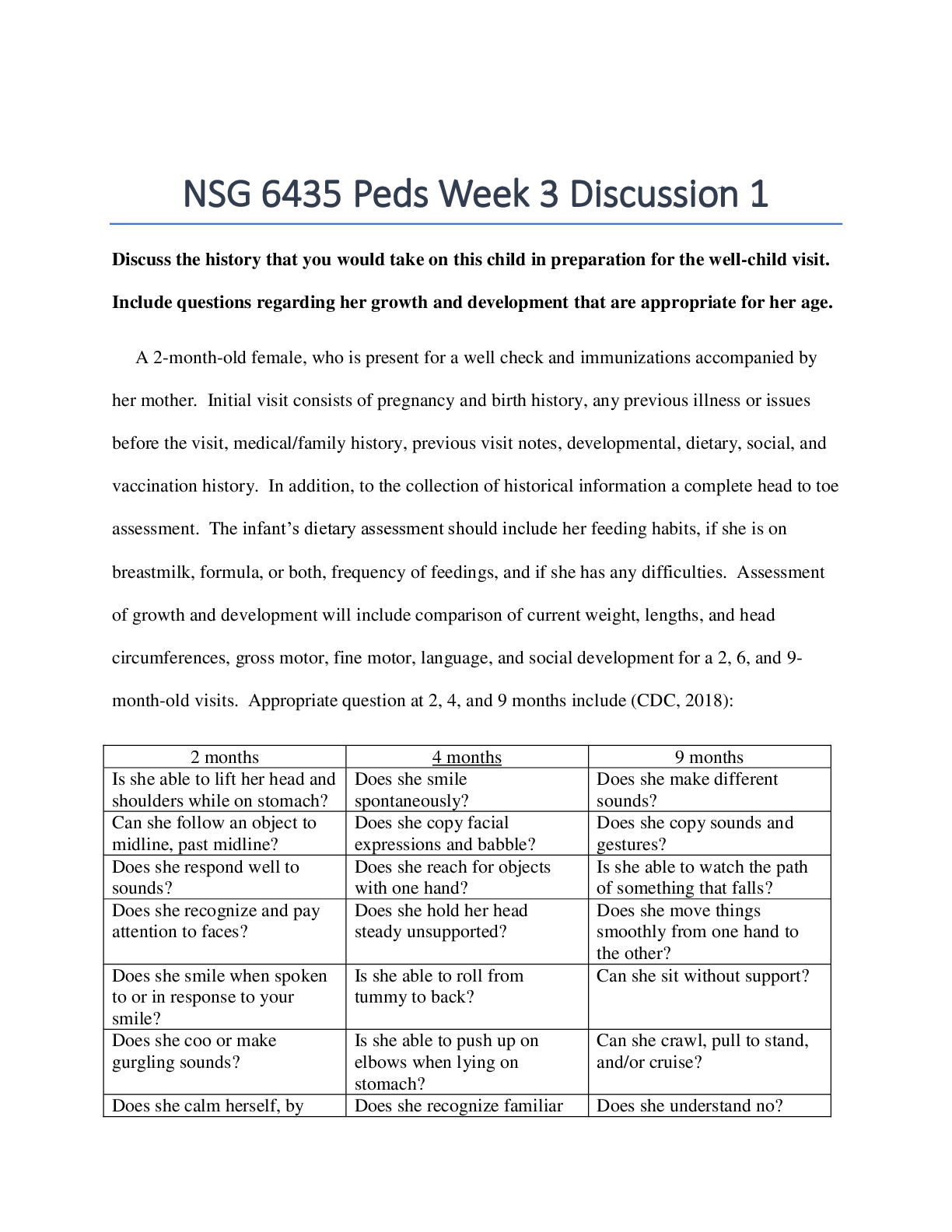
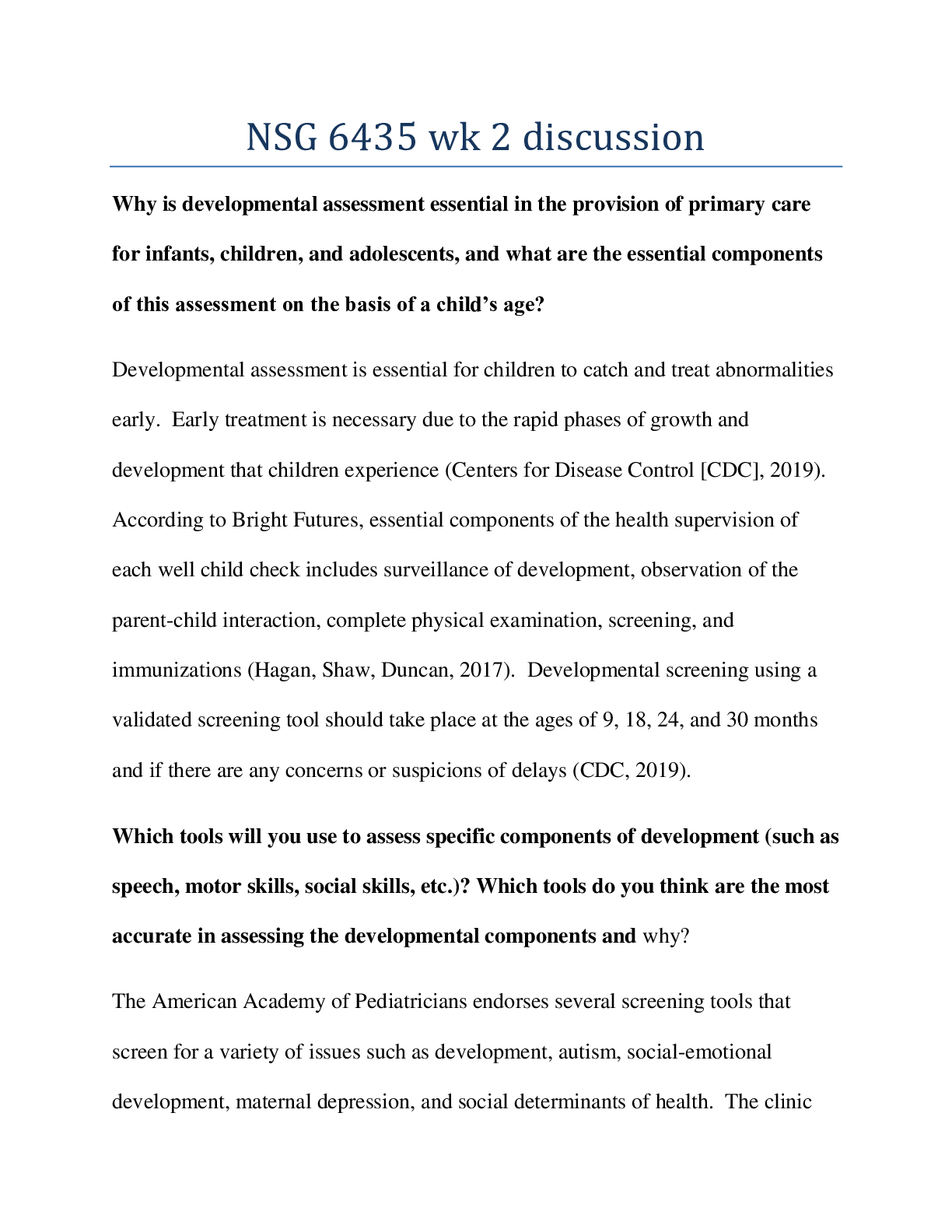
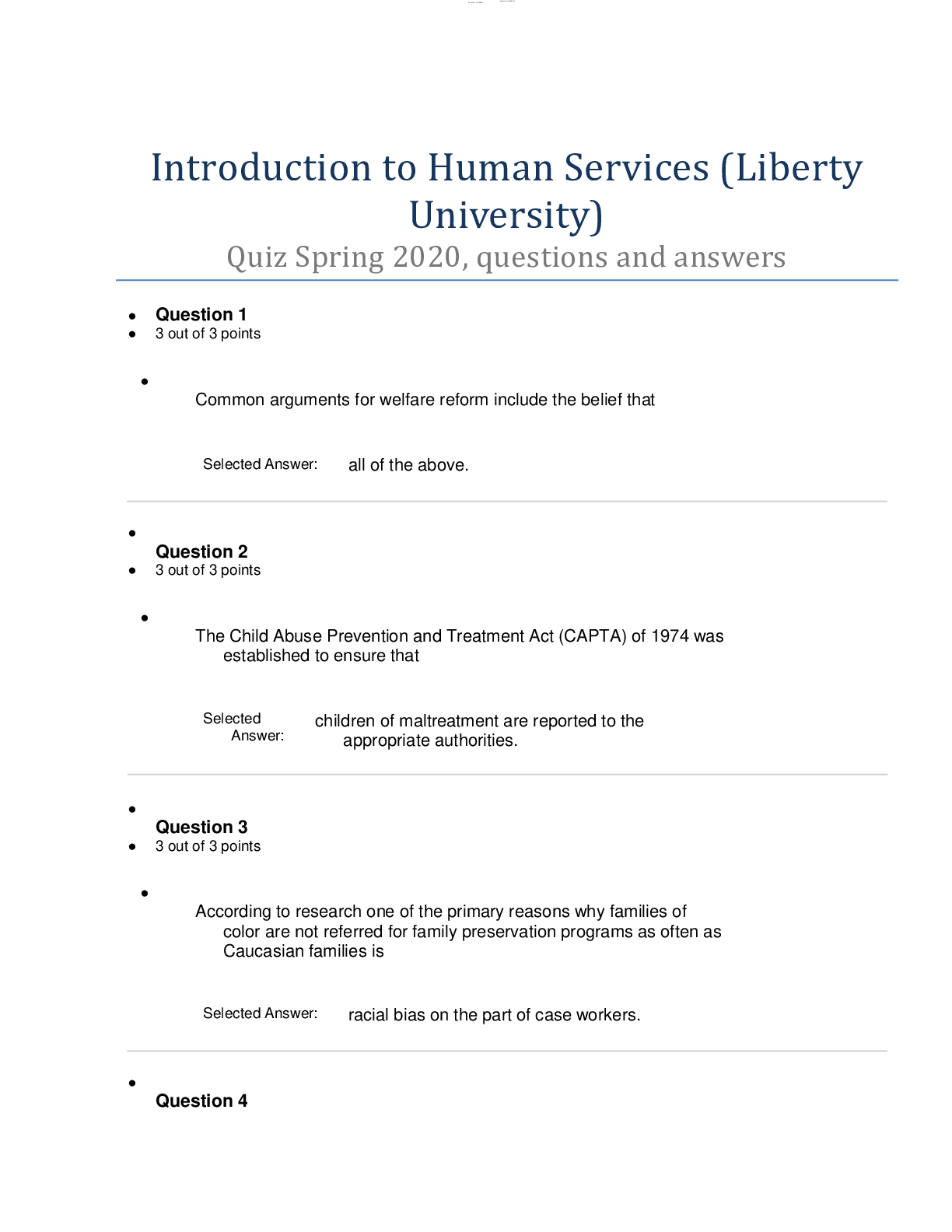

.png)

